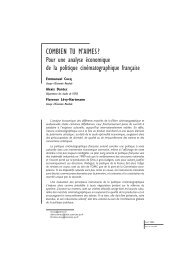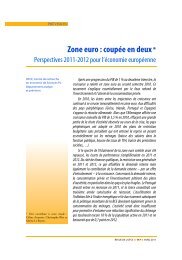direct multi-step estimation and forecasting - OFCE - Sciences Po
direct multi-step estimation and forecasting - OFCE - Sciences Po
direct multi-step estimation and forecasting - OFCE - Sciences Po
Create successful ePaper yourself
Turn your PDF publications into a flip-book with our unique Google optimized e-Paper software.
Direct <strong>multi</strong>-<strong>step</strong> <strong>estimation</strong> <strong>and</strong> <strong>forecasting</strong><br />
models. Their concern is that of predetermined variables <strong>and</strong> their interest lies in the design of<br />
<strong>estimation</strong> techniques which take full advantage of the dynamic structure of the series.<br />
Klein (1971) suggests a <strong>multi</strong>-<strong>step</strong> estimator which minimizes the ‘solution path’ as mentioned<br />
in Haavelmo (1940). His idea is that in general if the data generating process follows an AR(1)<br />
(which can readily be extended to include more lags or exogenous variables):<br />
y t = αy t−1 + ɛ t , for t = 1, ..., T, <strong>and</strong> |α| < 1,<br />
<strong>and</strong> it is wished to obtain forecasts of y T +h<br />
= α h y T + ∑ h−1<br />
i=0 αi ɛ T +h−i , for h = 1, ..., H, then<br />
least-squares <strong>estimation</strong> of the model leads to minimizing the criterion function:<br />
H∑<br />
T∑<br />
−h<br />
h=1 t=1<br />
( h−1<br />
) 2<br />
∑<br />
α i ɛ t+h−i =<br />
i=0<br />
H∑<br />
T∑<br />
−h<br />
h=1 t=1<br />
(<br />
yt+h − α h y t<br />
) 2<br />
,<br />
with respect to the coefficient α. In a simulation experiment, the author lets several parameters<br />
vary <strong>and</strong> his findings are that (i) <strong>multi</strong>-<strong>step</strong> methods seem to perform better in smaller samples<br />
(here 50 vs. 400), (ii) adding a trendless exogenous variable seems to help DMS, but a trending<br />
variable does not, <strong>and</strong> (iii) the initial observation does not affect the previous results. In applying<br />
this dynamic <strong>estimation</strong> method to the Wharton model, he finds that he can reduce the mean<br />
average prediction error (MAPE) from 6.29% to 5.33% in 2-<strong>step</strong> ahead out-of-sample <strong>forecasting</strong>,<br />
when comparing it to an IV <strong>estimation</strong> with principal components.<br />
Hartley (1972) studies the properties of the dynamic least squares estimator (DLS for him)<br />
suggested by Klein (1971) in the univariate AR(1) case. He shows that the new estimator is more<br />
robust to residual autocorrelation than OLS.<br />
Assuming that the process can be written, for t = 1, ..., T , as<br />
y t = αy t−1 + ɛ t , (2)<br />
ɛ t = ρɛ t−1 + u t , (3)<br />
where y 0 is fixed, ɛ 0 = 0, {u t } is an independently <strong>and</strong> identically distributed (i.i.d.) process whose<br />
elements have zero mean, variance σ 2 <strong>and</strong> finite third <strong>and</strong> fourth moments, |α| < 1 <strong>and</strong> |ρ| < 1,<br />
Hartley shows that if the dynamic solution path<br />
y t = α t y 0 +<br />
t∑<br />
α t−i ɛ i ,<br />
i=1<br />
6








